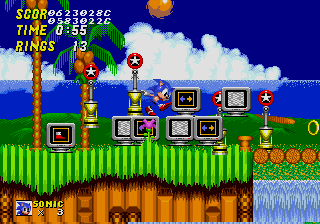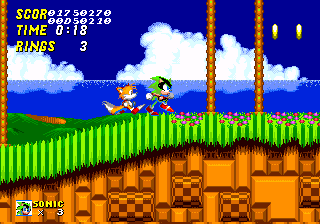Edit mode
From Sonic Retro
(Redirected from Debug mode)
Edit mode (エディットモード) is a gameplay feature of Sonic the Hedgehog games, first introduced in the eponymous 1991 game before appearing in many 2D Sonic titles thereafter. Usually enabled by entering a cheat code, it allows for objects to be placed in real-time, as an easier means for developers to test their behaviors.
In Japan, the term "edit mode" came into circulation from official Sega sources relatively early on in the series' life and was used internally during development of the 2D titles[1], however in the West, the mode was never officially named (until the likes of Sonic Jam (1997) appeared, calling the feature by its Japanese name). It was, however, referred to extensively by the printed press as debug mode, a name that subsequently became the de facto moniker outside of Japan, being used internally for Sonic & Knuckles Collection[2] and the 1996 Windows version of Sonic the Hedgehog CD[3], and eventually becoming an "official" term with the 2017 release of Sonic Mania.
The term "debug mode" is not strictly accurate, as while some information potentially useful for debugging is printed to the screen, useful monitoring of system processes or game code requires a Mega Drive development kit. It is, however, a far more popular term, and has influenced several other video games with similar in-game editing or monitoring features. For this reason, and its widespread use in English markets, the "debug mode" name is used extensively on this wiki and elsewhere to describe edit mode.
Contents
Features
Edit mode has evolved alongside Sonic games, with later entries in the series adding to its capabilities. When enabled, most follow the same basic control scheme:
Starting with Sonic the Hedgehog 3, other features have been added when edit mode is deactivated:
 reverses the gravity
reverses the gravity- Pressing
 and
and  at the same time causes every frame of the current character's animation to be shown in succession
at the same time causes every frame of the current character's animation to be shown in succession
While not exclusive to edit mode, two other features are usually made available when pausing the game with ![]() :
:
 will reset the game
will reset the game will cause the game to advance by one frame. Holding it can simulate slow motion.
will cause the game to advance by one frame. Holding it can simulate slow motion.
Implementations can vary on the game (and even across prototype versions). In the original Sonic the Hedgehog and Sonic CD, Sonic does not lose a life if hit without rings. In Sonic 3, edit mode can be activated during the dying sequence.
HUD
In addition, edit mode can cause the heads-up display (HUD) to acquire new functionality.
Sonic the Hedgehog
Sonic the Hedgehog 2
Sonic the Hedgehog 3 and Sonic & Knuckles
Sonic CD
Sonic Mania
IMAGE HERE
Issues
Edit mode was a tool designed to be used by developers, and while its inclusion in the final product is a fun Easter egg, no Sonic game is optimised to deal with it. That is to say, edit mode can easily cause bugs to manifest, either in the form of graphical glitches, or by straight-up crashing the game. It is impossible for the mode to damage the game ROM itself, but it can cause in-game slowdown and make levels unbeatable.
In the older games, when a placed ring is collected, monitor is destroyed or check point is switched, an internal flag is set which can never be "un-set", meaning these objects become unusable if placed again. The list of objects is not guaranteed to be definitive either - it is impossible to place Super Ring or Power Sneakers monitors in the original Sonic the Hedgehog, as object sub-types are not taken into account (all that can be placed is the "blank" monitor).
Some objects don't work, others are missing graphics, but others can offer a glimpse into the game's development, allowing the user to place objects in the stage that aren't usually seen. The Christian Whitehead ports of Sonic games (and Sonic Mania) take this one step further by specifically adding Easter eggs to edit mode, such as being able to restore the background UFOs in Marble Zone.
Sonic games featuring edit mode
Note: compilations (e.g. Sonic Jam) and enhanced versions (e.g. 3D Sonic the Hedgehog) also feature edit mode. Some mobile ports cannot access the mode without hacking, however, simply due to a lack of available buttons.
Mega Drive
- Sonic the Hedgehog (1991)
- Sonic the Hedgehog 2 (1992)
- Sonic the Hedgehog 3 (1994)
- Sonic & Knuckles (Knuckles in Sonic the Hedgehog 2, Sonic the Hedgehog 3 & Knuckles) (1994)
Mega-CD
- Sonic the Hedgehog CD (1993)
PlayStation 4, Xbox One, PC, Nintendo Switch
- Sonic Mania (2017)

